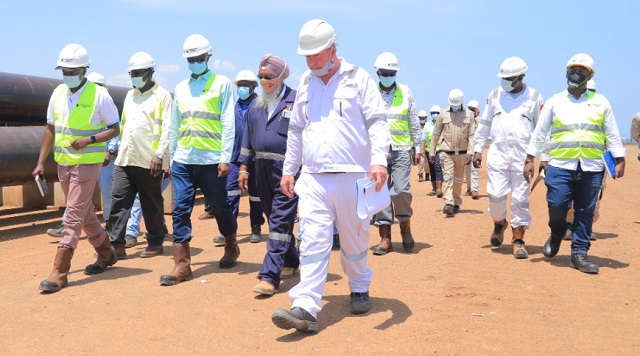
Oil projects expected to spur other sectors of the economy
Kampala, Uganda | RONALD MUSOKE | The government is impressed by the pace at which the critical infrastructure necessary for oil production that is now scheduled for the first quarter of 2025 is moving, said Ramathan Ggoobi, the Permanent Secretary and Secretary to the Treasury in the Ministry of Finance, Planning and Economic Development.
Ggoobi, who was on a three day visit of the oil and gas operational areas in mid-western Uganda, said the infrastructure gap which was one of the key challenges to commercialising the country’s oil and gas sector had been addressed by the government and he was impressed with the progress made in the sector following the announcement of the Final Investment Decision (FID) in February, this year.
“We have constructed over 70% of the critical roads, works on phase one of Uganda’s second international airport in Hoima are expected to be completed by February 2023, and the Uganda Petroleum Institute at Kigumba is skilling Ugandan technicians in the required international standard for the oil industry.”
“The deliberate efforts which have been undertaken by the government in terms of capacity building, regulatory and institutional framework has convinced me that Uganda has already escaped the oil course.”
His visit of the oilfields was coordinated by the Petroleum Authority of Uganda (PAU) — the government agency responsible for regulating and monitoring the petroleum sector in the country.
Ggoobi’s tour which ran from April 8-10 included a visit to the Uganda Petroleum Institute -Kigumba (UPIK), the Tilenga Project in Nwoya and Buliisa districts and the Kingfisher Development Project and the Kabaale Industrial Area.
Following the announcement of the FID by the Joint Venture Companies TotalEnergies, CNOOC Uganda, and UNOC, the oil and gas sector has seen a ramp up in activities with construction works, and award of contracts for the three major projects of Tilenga, Kingfisher and the East African Crude Oil Pipeline (EACOP).
The site preparation works on the Tilenga Industrial Area are already in progress and currently stand at 60% completion rate. The industrial area will host the main Tilenga surface facilities – central processing facility, the construction support base, the drilling support base, the construction camp and the operators support base.
MotaEngil was contracted by TotalEnergies E&P Uganda to undertake the site preparations. The scope of work includes bush clearing, levelling, compaction, drainage, fencing among others.
To meet national content requirements, MotaEngil has employed over 300 Ugandans with only 24 non-Ugandans and is working with different Ugandan sub-contractors including Prand Engineering Ltd, Civtec, Pearl Engineering, among others to perform different tasks of the site preparation contract.
Similarly,construction works forthe other key project, the Kingfisher,are also on-going following the award of the procurement contract to Excel Construction Ltd, a Ugandan company. The scope of Excel Construction Ltd includes building well pads, 2.5km fence, access roads and water intake points.
Early last month, a total of 86, 24-inch conductor pipes were delivered to the well pads. Installation of these pipes requires welding the pipes together before they are run into the ground.
This was done by a group of Ugandan trained welders who benefited from the different training interventions in the country. The site preparation works currently stand at 10.10% against a planned 10.34%.
Ernest Rubondo, the executive director at the PAU, said the oil projects being developed in the country will have a trickle-down effect and impact other sectors of the economy and create positive contribution to the population.
“If these oil roads had not been constructed, movement of equipment needed in the oil sector would have been a challenge, but you should also recognise that these same roads are benefiting other sectors of the economy like agriculture, transport and tourism,” Rubondo said.
The PAU is currently spearheading two studies to define business opportunities in the agriculture, and housing sectors linked to Uganda’s emerging oil and gas economy.
The study is expected to estimate the current and future demand and supply, assess the status of standards, as well as document active agricultural enterprises with potential to absorb emerging opportunities linked to the oil and gas activities.
Following the recent launch of the Parish Development Model, Ggoobi said his ministry was impressed by the progress that has already been registered in the oil and gas sector. While in Hoima, Ggoobi visited the Stanbic Business Incubator.
He said the finance ministry would undertake a similar approach to see how the parish development model can feed into the enterprise development by the oil and gas sector players.
“My team is going to review this and ensure that the communities living within these areas are prioritised during implementation of the parish development model to consolidate these efforts,” he said.
According to Dr. Michael Nkambo Mugerwa, the General Manager of the Uganda Refinery Holding Company Ltd, a subsidiary of Uganda National Oil Company (UNOC), new projections by the government show that the oil and gas industrial park, once operational, is expected to rake in about US$8bn (Shs 28 trillion) annually. This is about 7.7% of Uganda’s current GDP that stands at US$37.7bn.
“This is why there is need for the government to fund this project to its full implementation due to the immense potential for sector linkages, and the need to broaden the economic resource base of the country,” he said.
****
 The Independent Uganda: You get the Truth we Pay the Price
The Independent Uganda: You get the Truth we Pay the Price



